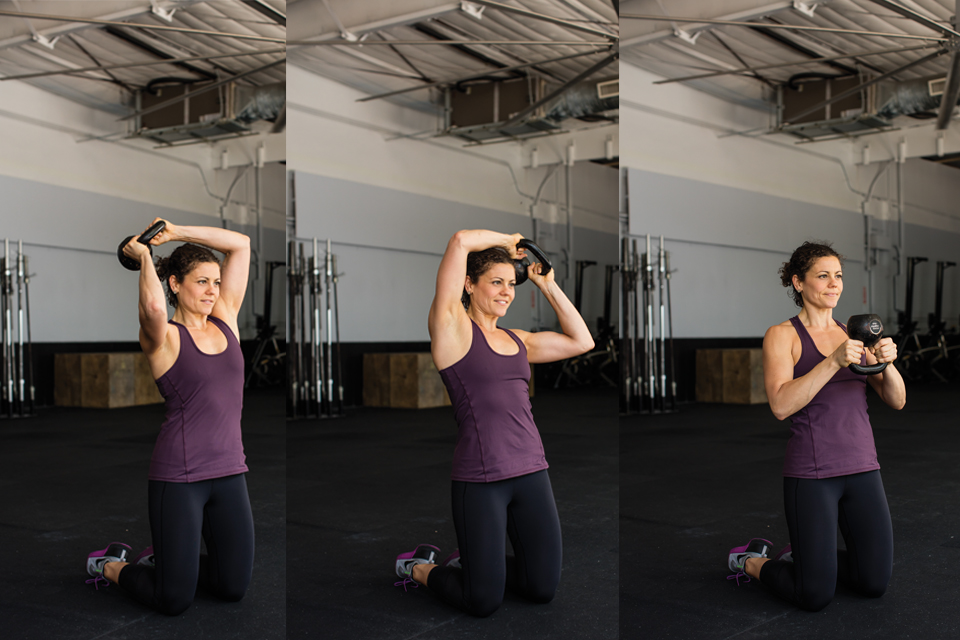Getting Fit for the AFM FITTEST

In fitness, we often think about workouts in terms of calories burned or how hard the circuit pushed us; placing less emphasis on the movement quality or how well the movements translate to our overall fitness abilities.
The following is a Fit Set—a circuit incorporating lower body strength, upper body strength, core stability, and agility movement. This covers total body fitness while building movement skills that will allow you to tackle many life- and sports-related challenges. It’s a good cross-training circuit strategy; especially if you’re getting ready for the AFM FITTEST competition on May 30.
This circuit will help enhance your ability to transfer your athleticism to things you would do on vacation, with the kids, or even in that weekend pick-up volleyball match. Using this Fit Set strategy allows you to go back to your own exercise menu and pull in new movements aimed at building purpose-driven movement.
Outline for building a movement-focused circuit:
1. Level Changes/Lower Body / 2. Push and Pull/Upper Body / 3. Rotary Stability and Rotation/Core / 4. Locomotion/Speed, Agility, Quickness

Goblet Squat with Kettle Bell
Purpose: Focus on lower body movement, which in turn focuses on lower body mobility and dynamic motor control. Work on maintaining static motor control/stability for the upper body and core.
Start: Standing with feet at shoulder-width distance, hold the kettlebell with two hands in a front carry position, just in front of the chest.
Bracing the core, bend at the ankle, knee, and hips so that the hips drop between the feet in a vertical descent.
Feet should be flat at all times, and the torso and shins should be parallel in the bottom position, with knees tracking just behind the second toe.
Lower the kettlebell, keeping it in position close to the body, elbows traveling vertically down toward the upper thigh.
Push through the heels to return to a standing position and finish in full extension of the lower body, making your spine as long as possible at the end of each repetition.

Pull-Ups with Towel Grip
Purpose: Focus on upper body strength to strengthen the dead hang pull-up movement. The use of a towel grip enhances grip strength, which transfers to improved performance in the handgrip test.
Start: Drape a towel over a secure pull-up bar. Using a claw grip on the towel, start with the arms fully extended in the low position of the pull-up.
Using your arms, shoulders, and upper back, pull your body vertically up until your shoulders are fully extended and elbows are in line with your torso.
Be sure to keep your gaze forward, neck neutral (vertical), and torso upright with chest up. Avoid any caving in of the chest, as this weakens the position and reinforces rounding of the shoulders.

Half-Kneeling Halo
Purpose: Perform a circular motion around the head and shoulders that challenges dynamic stability of the upper body while maintaining static stability of the torso and lower body.
Start: Place left knee on a padded but firm surface while creating a straight line vertically with the same hip and shoulder. The right leg’s shin should be vertical and directly in front of the right hip so that the hip and knee are at 90 degrees.
Hold the horns of a light kettlebell in the bottom up position in front of the chest. To perform the halo, reach with the bottom of the kettlebell over the shoulder, around the head and shoulders, then over the opposite shoulder to return to start.
The lower body and neutral position of the spine should remain motionless during the halo.
Perform the halo at a slow and controlled speed. Complete 5 reps in one direction, then reverse the direction of the halo for 5 reps in the opposite direction.
Switch the half-kneeling position with the opposite leg forward and repeat the repetitions in both directions.
5-yard/3-Point Turn
 Purpose: A locomotive drill that emphasizes short changes in direction as fast as you can maintain control and form. This will kick up the intensity at the end of the circuit while practicing the skill of direction change for agility.
Purpose: A locomotive drill that emphasizes short changes in direction as fast as you can maintain control and form. This will kick up the intensity at the end of the circuit while practicing the skill of direction change for agility.
Start: At the start cone, use a standing start and then sprint out to a cone 5 yards out.
Lower your center of mass as you quickly decelerate at the cone and touch behind the cone with your foot.
Change direction and sprint back to the start cone. Perform the same change of direction back to the 5-yard cone.
Change direction one last time to return to the start cone and finish the drill.
Rest for 20–30 seconds and repeat the drill for 5 repetitions.






